So you want to plant a vegetable garden. Determining what vegetable gardening style to use a great first step, & determining the type of vegetable gardening method you will utilize is the next.
This post may contain affiliate links at no additional cost to you. By making your purchases through the links on this website, IMSL may make a small percentage at no direct cost to you. IMSL only promotes products we use & truly believe in. Please refer to my Privacy & Disclosures for further information. IMSL thanks you for your support!
As with any new endeavor, it’s easy to be overwhelmed with all that needs to be taken into consideration. I get it. When it comes to planning a new vegetable garden, or a new layout for an existing one, it can be a lot.
So what is the difference between a garden “style” and a garden “method”? For the purposes of this article, when speaking of a garden-style, I am referring to the hardscape of the garden. The physical makeup of the garden space. Gardening methods refer to how the garden is planted and maintained.
Realizing that first and foremost, the garden needs to be a functional one for the space you have to work with is key in helping to determine what style garden you will utilize. No matter if you are looking for a few pots outside your kitchen door to nibble on or seeking to supplement your entire food supply by storing & preserving for the winter months, the space needs to be functional. Determine your goal(s).
Our “organizing the homestead” series may be of help with your goal setting. Be sure to check out our article “Setting Goals” to help you along the way!
Need additional help in organizing the gardening approach? Our printable Garden Management Planner can help you do just that. Year-after-year 🙂
Taking self-inventory is another great way to help determine what style of vegetable gardening would suit you best. Asking yourself a few questions will assist.
- Do you like things tidy & organized?
- Do you enjoy & thrive with a bit of chaos?
- How much time do you have to work in your garden? Will you have assistance, or are you solo?
- Are you looking for a style that is functional AND beautiful? Or are you most concerned with the environmental impacts your space may have?
You get the idea. Asking yourself what you want from your garden space, how you would like it to look aesthetically, and what your goals are for the space you have are all great starting points.
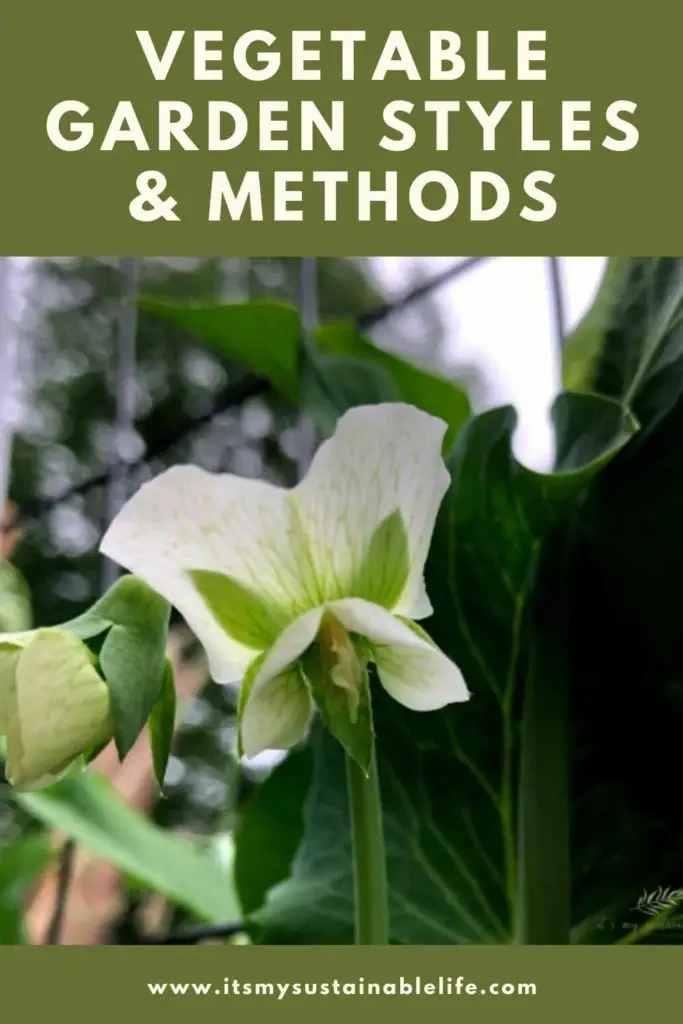
DIFFERENT TYPES OR STYLES OF VEGETABLE GARDENING
Consideration of how you would like your gardening space to look, the type or style of vegetable gardening you will be utilizing should be made.
Types & styles of vegetable gardening really refer to the hardscape of where you will be growing your vegetables. A few examples of the types of vegetable gardening are found below.
IN-GROUND VEGETABLE GARDENING
In-ground vegetable gardening is just that. Vegetables that are seeded and/or grown in the ground. If you have the land, & your soil is good, this type of approach may be just the ticket for you! AND it’s probably one of the most economical approaches to creating garden space there is. No need for additional building or supply purchases needed to begin!
An approximate 500 square foot in-ground garden can feed a family of four for approximately 8 months out of the year! Beware, this approach is easy to “over-do” initially. A good starter size garden would be approximately 50-70 square feet.
Over the years my gardening style has changed and morphed to suit both our needs as well as our backs, just sayin’ 🙂
Our garden space is approximately a 50 x 40 foot space or about 2000 square feet. When in full swing, my food stores will last a complete year with plenty of fresh produce to eat and share in the growing season.
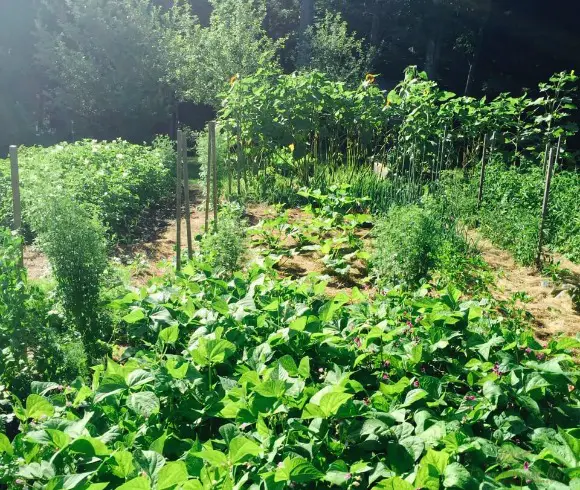
With few tools (a hand tiller & compost) needed to create your space if your soil is good (we highly recommend getting your soil tested through your local Extension office), this approach is by far the most economical to begin. You can even source your seeds and root vegetables you will be planting from the fresh produce you purchase if organically sourced!
Other considerations are…
- Protection from predators (we have a lot of wildlife in our area as well as raise bees, thus the electric fence enclosing the garden space)
- Trellis or stakes for growing certain varieties of produce such as tomatoes
- Mulch to help reduce weeds if needed
- Water access
In this style vegetable garden, you are only limited to your own imagination as to what you can grow & what gardening method (conventional, permaculture, beds, intensive) you would like to use! A good beginner garden will focus on what you & your family enjoy eating. A few suggestions of common vegetables are…
- Cucumbers
- Tomatoes
- Onions
- Corn
- String Beans
- Cabbage
- Beets
- Melons
- Squash
However, experimentation with other varieties or vegetables you normally would not purchase are highly recommended & fun to try!
RAISED BED VEGETABLE GARDEN
Raised bed gardening is basically a garden that is at a raised level, some even placed on “legs” to raise the level even further, with the garden soil being contained by units of wood, rock, concrete or some other sturdy material.
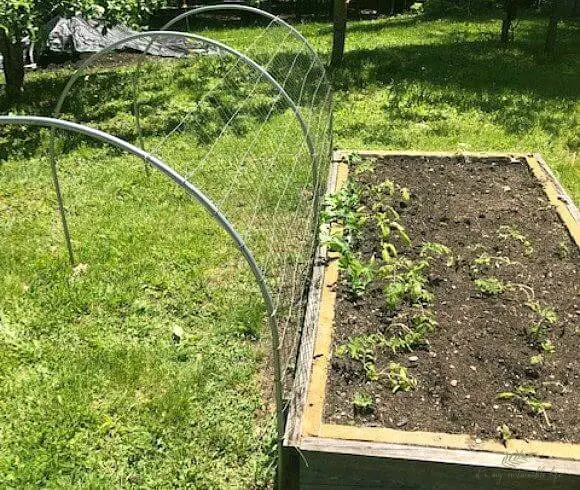
Gardening in a raised bed saves your back…less bending etc is needed when using this style. It also is the perfect style of vegetable gardening when you have poor or rocky soil as the majority of the soil in the bed is simply placed on your existing base.
Pre-purchased raised beds can get pretty pricey, and the supplies needed to create your own would need to be taken into consideration if budget is of concern. Popular now are livestock troughs which can be sourced easily from large box home improvement stores, but again can be pricey.
Keep your eye out soon for how we are relocating and building 2-3 new raised beds, with cost breakdowns and ideas for building your own.
In addition to the bed itself, you will need a few supplies to create your raised bed; topsoil/compost, newsprint or plastic for the base, seeds/plants, a hand tiller and access to water would be needed.
This gardening style lends itself well to several methods of gardening. Vertical gardening, square foot gardening, permaculture, & row gardening are just a few to mention.
Anything you can grow in an in-ground style garden you can pretty much grow in a raised bed. I like to use my raised beds for the more work intense crops like carrots, as it saves my back! Be sure to check out our article “Thin Carrots The No Waste Way” to see exactly what I’m speaking about here 🙂
SQUARE FOOT OR BLOCK STYLE VEGETABLE GARDEN
The square foot or block style vegetable garden is just that. It’s a garden bed that has been blocked into 1 square foot sections, usually using wood, string or some other method of separating the squares, creating the style.
Typically, one variety of vegetables would be planted in each individual square, creating the square foot gardening method.
Below is an example of a square foot garden layout that is graciously supplied to us by Vegetable Gardening Online.
The options of vegetables to grow shown in the graph above are good ones to grow in a square foot garden, but should not be considered the only options.
INTENSIVE VEGETABLE GARDENING
Intensive gardening style is pretty much the same as the above square foot gardening method. Intensive gardening is maximizing space through strategically planting in a grid-like format.
CONTAINER, PATIO, & POT VEGETABLE GARDENING
This style of vegetable gardening may be the most versatile out of any style as it’s easily done just about anywhere. Apartment dwellers, city & urban dwellers alike can easily incorporate this style gardening into their lives no matter where they live.
This gardening style is obviously not large scale, but one could easily grow their favorites such as tomatoes & basil or maybe a pot of cucumbers which can easily be trellised upward.
Limited in what gardening methods may be explored, one can easily incorporate companion planting (one plant feeding & supporting the other in some way) and even vertical gardening when growing in containers.
Even those with the luxury of having larger gardening spaces will often incorporate a few container gardens placed strategically near their kitchen or into their layout. I not only have my large in-ground garden area but have also created an herb bed located near my kitchen. Be sure to take a peek at Herb Bed! Recreating a Loved Space to see how we created it.
By grouping plants that have similar needs (light, water, etc) into one pot will create the perfect environment for success. Think tomatoes, lettuce, beets, and basil.
VERTICAL OR TRELLIS VEGETABLE GARDENING
Vertical vegetable gardening, considered to be both a gardening style & method, is just that. Growing vertically or upward. This gardening style is one that can easily enhance any patio or small space garden by utilizing wall space and/or space that otherwise would not have been accessible.
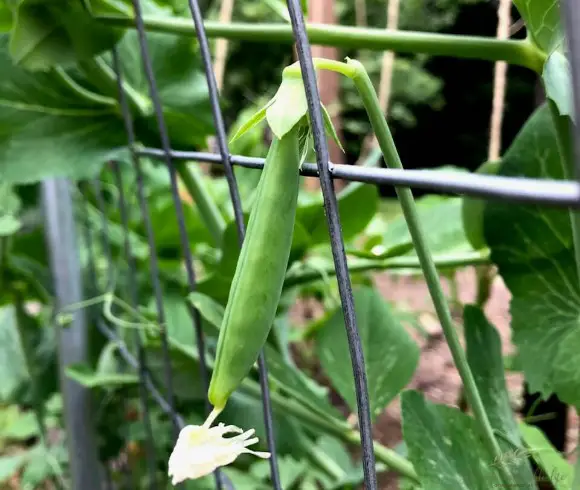
Vertical gardening is also an easy way to not only create additional space but also to beautify a gardening space by using obelisks, trellises, and other structures to create support and interest in the garden.
In another of my very early gardening layouts (thus the old pic below), you can see I utilize some vertical gardening methods (the stakes displayed) for my tomatoes.
I grow an enormous amount of tomatoes each year (150 plus plants) and plant them very close together, by using a vertical growing method call “basket weave” or “Florida Weave” method, I can easily fit and grow that amount easily. More on that to come this summer!
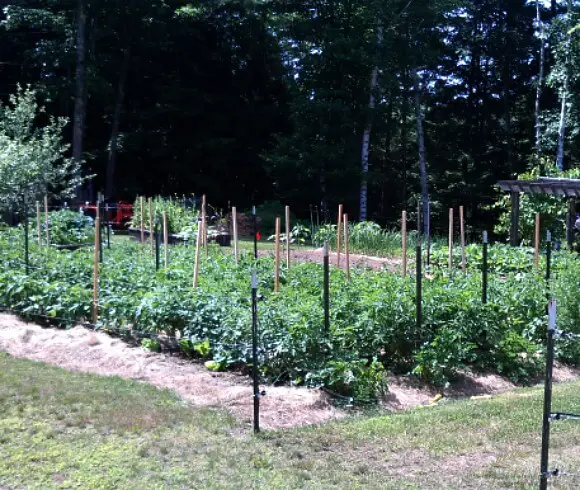
I know, a crazy number of tomato plants right? But believe me, we use them creating & canning salsa, tomato sauce, and whole tomatoes, learn how to prepare yours to can here, to name just a few.
COMMUNITY VEGETABLE GARDENING
Community gardening is a great option for those living in city & urban areas that do not have access to viable gardening spaces. This gardening style builds a strong sense of community while allowing a large group to work the land either with gardening their own plots or as a collective group.
By actively participating in a community garden, you not only reap the benefits of gardening in general (strengthens the physical body, relieves stress, & builds a strong sense of well-being as well as creating & enjoying your own food) but also increases your social opportunities & builds a strong sense of community. WIN, WIN!
UNIQUE VEGETABLE GARDENING METHODS
Below find a few unique gardening methods (how you plant & care for your garden) and some you may have already heard of. Hopefully, these descriptions will help you determine the best vegetable gardening method right for you.
CONVENTIONAL VEGETABLE GARDENING METHOD
Conventional gardening is a method of gardening largely used by industrial agriculture systems that utilize the use of GMOs (genetically modified organisms), synthetic chemical fertilizers, pesticides, herbicides and who knows what else.
The conventional gardening method mindset is to grow what you want no matter the cost to the land, the plants, and ultimately the food.
Not sure about you, but not a method I would actively seek out if I were interested in supplementing my family’s food supply. Just sayin’ 🙂
ORGANIC VEGETABLE GARDENING METHOD
The organic gardening method is completely opposite of the conventional approach. Utilizing no synthetic fertilizers or pesticide/herbicide treatments, growing organically relies largely on soil building and utilizing sustainable practices that replenish what it uses.
This is the method of gardening we have utilized for the past 16+ years. I am incorporating other approaches as well, however, such as the Ruth Stout Method (listed below) and the no-till method as well, promoting soil health, reducing water usage, and saving, you got it, my back 🙂
PERMACULTURE VEGETABLE GARDENING METHOD
The permaculture gardening (permanent agriculture) method is, however, a complete 180 from that of conventional gardening. This sustainable gardening method is one that we have been slowly incorporating into our methods for some time now.
This gardening method incorporates the use of appropriate plants that work naturally with light, moisture, and wind. For example, planting taller varieties such as sunflowers in a strategical location that will block the harsh winds and strong sun from damaging a more sensitive crop such as lettuce.
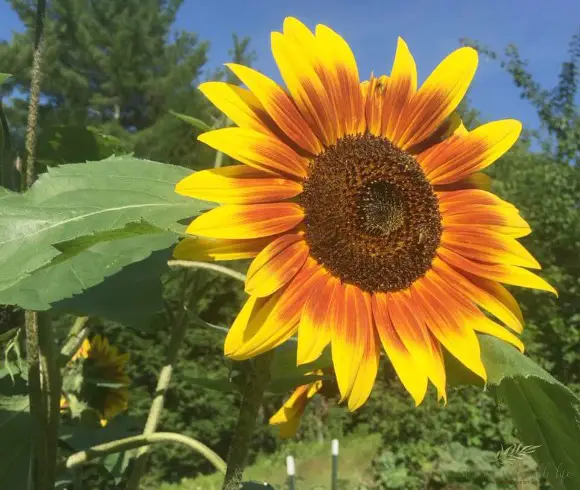
This gardening method works in harmony with nature and it’s rhythms holistically, and synergistically.
NO DIG NO TILL VEGETABLE GARDENING METHOD
No dig or no-till gardening is also referred to as lasagna gardening. This method of gardening requires no tilling or turning the soil under and composting narrow rows of plants within the garden beds themselves.
I have used this method for the past 3 years and have seen a marked improvement in my soil quality and beneficial pollinators (both ours and natures) and insects.
BACK TO EDEN VEGETABLE GARDENING
This gardening method is a completely organic & self-sustaining approach to gardening. It’s about using and harnessing moisture in the soil and keeping the harsh elements out (sun/wind).
Paul Gautschi, the creator of this method, says it best in his film, “Back To Eden Organic Gardening”. Be sure to click on this title if you would like to watch this short film in its entirety for free.
This is one method of organic gardening that I have yet to explore. May be a new project in the near future?
MITTLEIDER VEGETABLE GARDENING METHOD
Dr. Jacob Mittleider’ gardening method claims higher yields using less water and space. Recommending “grow boxes”, spaces made up of specific media (soilless composite of roughly 1/3 sand and 2/3 sawdust) with the bottom in contact with traditional soil, his method of gardening “focused on vertical growth, low but focused watering, and high nutrient infusions” according to “Gardening Know How”.
RUTH STOUT VEGETABLE GARDENING METHOD
Ruth Stout, born in the late 1800’s became known as the “Mulch Queen”. Her approach to gardening recognized that traditional approaches (tilling, plowing, weeding, & digging) typically utilized in most garden beds did nothing but disrupt the natural soil & it’s inhabitants. Not to mention being extremely labor-intensive.
Her remedy? Maintaining a thick mulch or layer of hay permanently on the soil. This is a method I have utilized and incorporated in my garden beds for the last few years and works incredibly to reduce the need for weeding and keeping moisture in thus reducing the amount of watering. Not to mention the fact I like to work smarter not harder these days 🙂
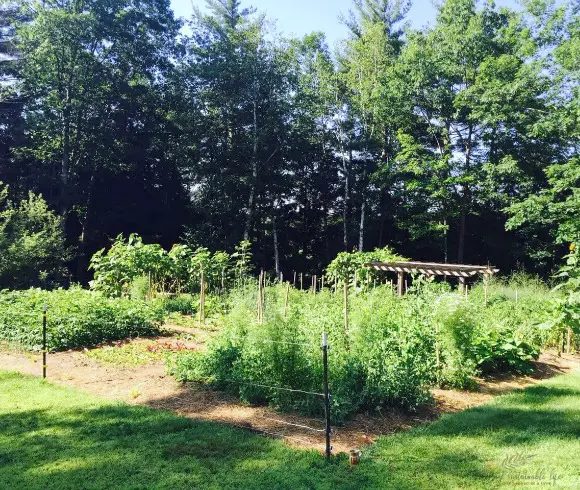
HUGELKULTUR VEGETABLE GARDENING METHOD
Hugelkultur, pronounced hoo-gul-culture, translates meaning hill culture or hill mound. Hugelkutur are basically a no-dig raised bed style of gardening with a bit of a twist. They hold moisture and maximize growing volume & space.
This European (largely German) technique uses woody debris to mimic the forests growing patterns. Using fallen branches, twigs, and logs are used as a resource in creating these mounds.
Often employed in permaculture systems, hugelkultur allows gardeners and farmers to mimic the nutrient cycling found in a natural woodland to realize several benefits. Woody debris (and other detritus) that falls to the forest floor can readily become sponge like, soaking up rainfall and releasing it slowly into the surrounding soil, thus making this moisture available to nearby plants.
Permaculture News
This method of gardening works extremely well in more difficult locations (hills, slopes, rocky soil, poor soil, and areas with drainage issues). This is one method of gardening I may give a try on a particularly severe slope we have on our property.
These are just a few of the many styles and methods of gardening. Hopefully, they will assist you in determining what approach will work best for you!
I would love to hear about your experiences using any of these styles or methods by joining in the conversation below! Have others that are not mentioned? I would love to hear about them. Happy gardening!
Love, Light, & Laughter ~


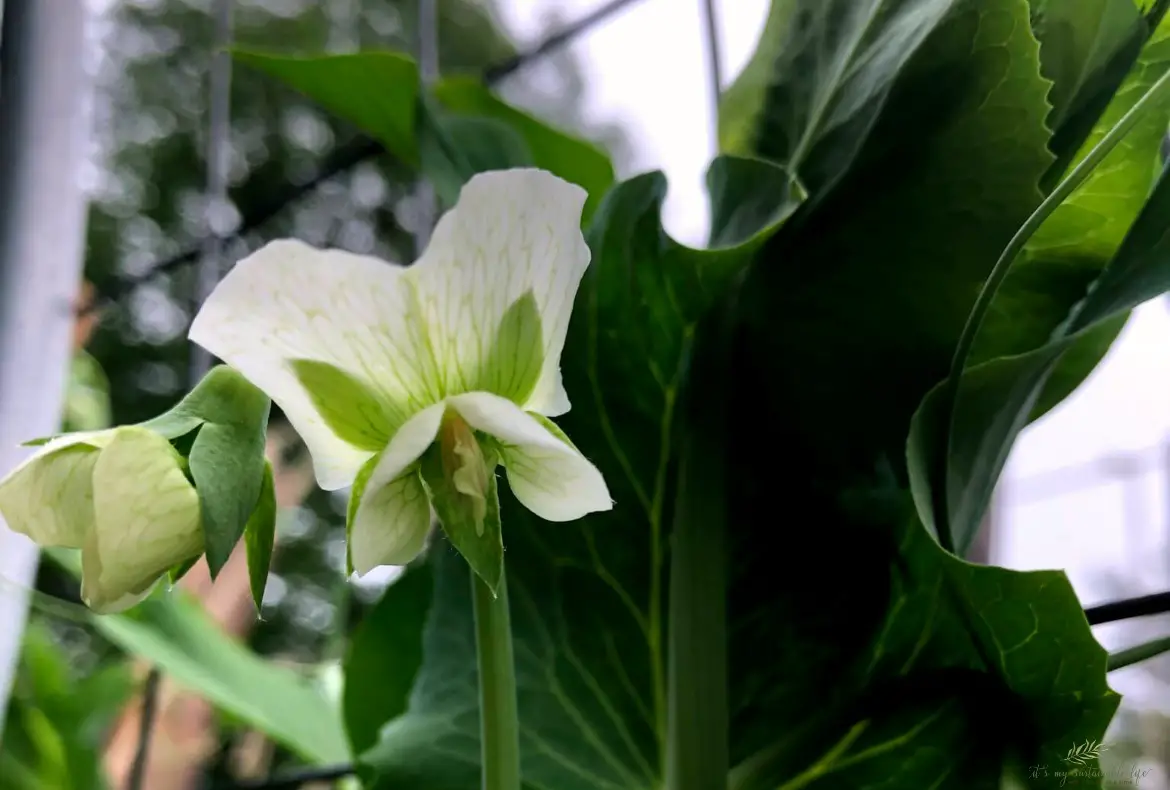

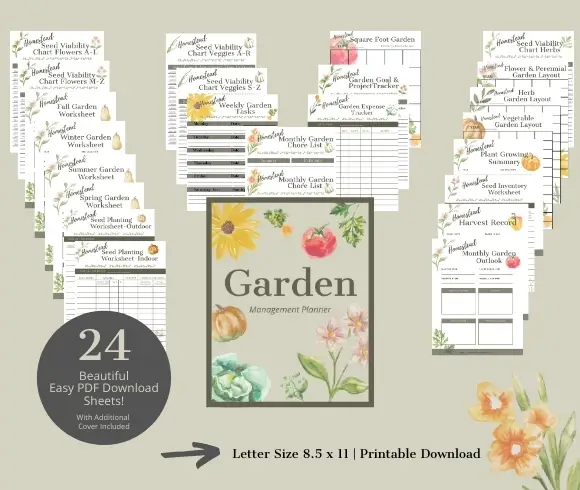
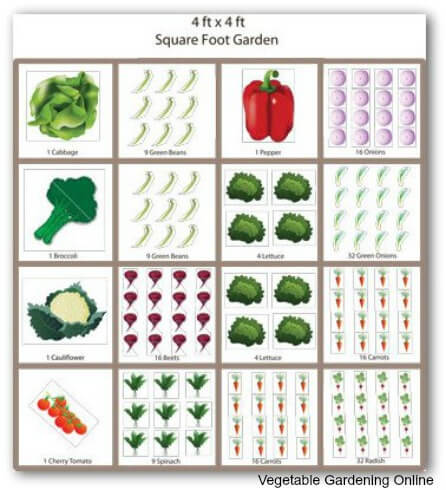
48 comments
Everything is dormant here as we wait for winter, but I enjoyed your garden pondering.
Thanks for sharing with us at Simple Homestead Blog Hop! There is something in here for everyone, what a great post! And it is one of the features at this week’s hop – see you there!
Melissa | Little Frugal Homestead
I love how you are so thorough with your coverage on the different gardening styles. I’ll have to save this and keep coming back as I try different ones.
I love organic, raised bed gardening! But I will say, this post has my imagination running wild at the different possibilities this year. Thanks for the in-depth post!
I had no idea there were so many types of gardens!
So many great details on gardening. How helpful!
This is such great post I love these ideas!
I love all of this! I love veggie gardening and need to get back to it! I have little ones that would just love behind a part of planting and harvesting! Thank you for all of the tips and suggestions!
I am totally a neat and tidy sort of person
Me too 🙂
As always you blow my mind with all that needs to be considered!
We do a lot of mulch gardening too and the last few years have experimented with Hugelkultur. We have lots of clay and rock and it has worked really great for us. Thanks for sharing with us at the Homestead Blog Hop!
Your post has also been chosen as one of our features this week!
Thank you for the honor, Ann!
Hugelkultur is definitely on my list of gardening approaches! Thank you for reading, Ann!
I would love to do some raised bed gardening someday soon.
So much great information. I’ve been hearing a lot about PERMACULTURE VEGETABLE GARDENING METHOD, so I’m glad you explained it for me.
Every time I read your posts, I want to start gardening. However, we are not good at keeping plants alive let alone food! We have grown tomatoes in pots but that is about it. I am going to share this with my husband as he is always looking for new challenges during the spring and summer months.
Hahaha! Tomatoes are always good 🙂
Wow, thank you for these tips. Our yard needs to be better utilized and a vegetable garden would be a great way to use the land!
I love raised bed gardening, thanks so much for sharing your wealth of information!
My dad has been gardening for a long time. He uses the raised bed method. And, lots of fruit trees too.
Lots of great gardening information. I love trying new veggies and flowers in my pots and beds.
A lot of great information! I love planting gardens, I haven’t planted one here since we moved. I’m going to read again!
Great article! I have property that was a piece of a farm, so hopefully next year I can start gardening! I can’t wait to come back to this to refresh myself when the time comes.
I have been wanting to plant a garden for a long time. This year we are considering doing a raised garden so it’s easier to take care of i love all your ideas. Thank you for sharing.
I would LOVE to plant a veggie garden but just the thought of starting seems overwhelming but each time I read one of your posts, I am inspired a wee bit more!
Great post Suzan! I know nothing about gardening but would love to learn more. Do you offer any videos or webinars about the topic?
I’m so glad you enjoyed it, Jill! I do have a few short videos up and running on You Tube, be sure to check it out! Right now I do not have any in depth offerings, but hopefully in the very near future there may be some offered!
Had no idea there were so many gardening types. Very interesting!
Great tips! I already have raised beds so maybe I will give it a go this season!
Gardens are so much fun! Hopefully, we are able to plant a small one soon.
Love vertical gardening – learned some great idea from this!
I have a raised garden. Very small. I do not have time to start or manage a larger one but I do the small one just because I love to grow things. This year was a little chaotic because I just put seeds that I retrieved from our organic grocery store veggies. Now I can not remember specifically what varieties I planted now that the veggies are starting to come out. Maybe a grape tomato or maybe and heirloom. Time will tell!
LOL! Suprises are always good!
I started a vegetable garden 3 years ago. I use raised beds and enjoyed seeing my hard work come to light. Last year it rained so much during the weekends, I never had a chance to get plant anything. I am hoping to change that this year. I grow tomatoes, cucumbers, zucchini, strawberries, mint, and kale. I would love to try butternut squash and pumpkins this year.
Mother nature can be so difficult at times! Hopefully, she will cooperate a bit more this year!
Very informative! I’m fascinated by the different methods of gardening–I didn’t know there are so many!
This is very thorough and informative information. The electric fence to keep predators away is a great idea! Thank you for your post
as always, your post is thorough and well laid out. AND it makes me want to have a garden SOOOOOOOOO bad!!!!! Whenever I get out of this concrete jungle, I’m hiring you 😉
I have a wee little porch and it’s full of plants… mostly herbs but at least it’s a little green….
Hahaha! So glad you are taking advantage of the space you have available!
Great post! It helps me remember that Spring will eventually come. We are still waiting for the frost to leave the ground so we can till our garden.
As am I, Tim! Thanks for stopping by.
I learn so much from about gardening from you! I need to get better at it 😭
We’ve gardened for years yet I found some very helpful information here! Thank you! My husband and I are in our early 60’s and our style has also morphed over the years as our body starts to protest 🙂
We live in the country with a mountain right behind us and a lake in front of us. It is like a wildlife highway. It makes gardening near impossible. Yours looks fantastic though!
We are the same here, Cindy. Thus, our electric fencing!
I love gardening, and have always had an organic garden beds only using flowers and herbs and a few essential oils for pest control. It did take awhile to get the soul on the condition I wanted..now after 3 years it amazing and very fruitful